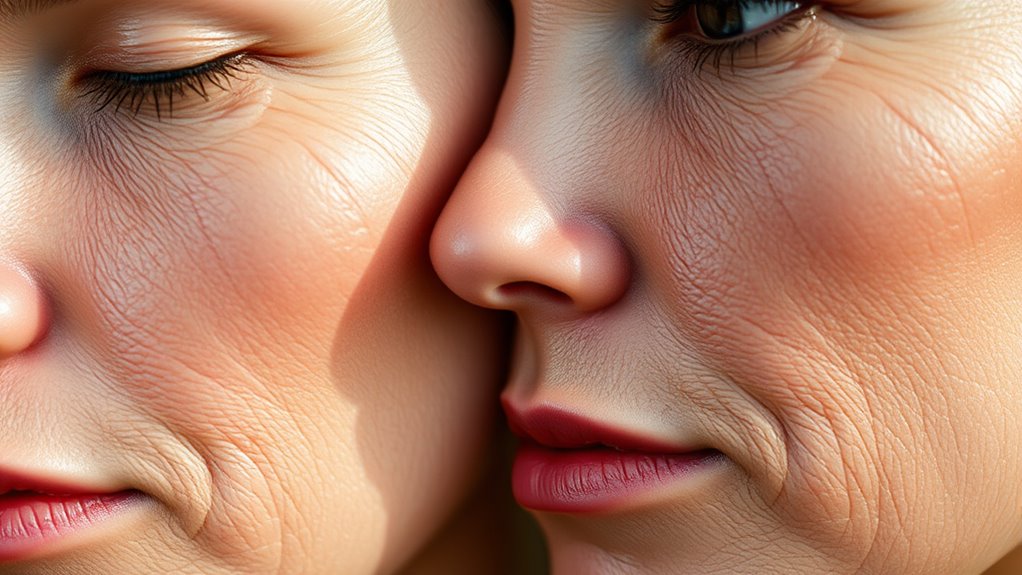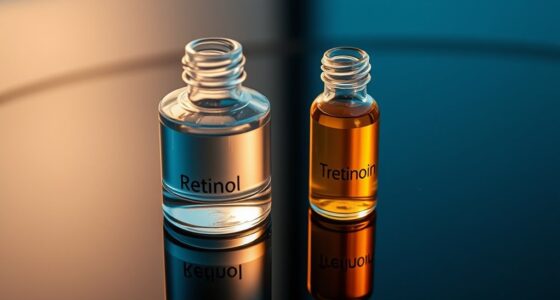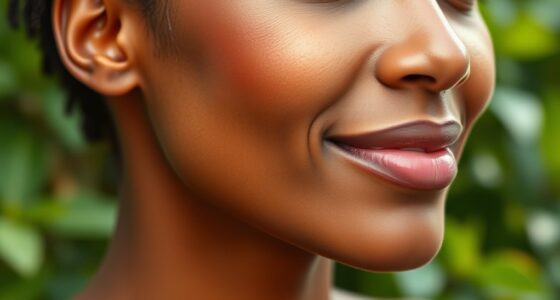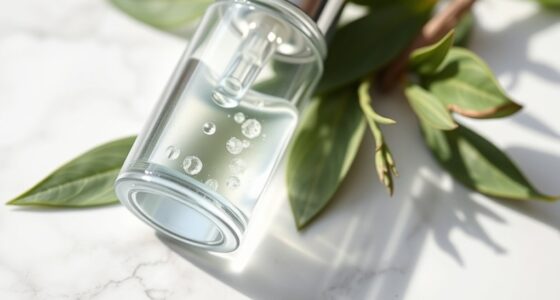Glycation happens when excess sugar bumps into your skin’s collagen and elastin, forming harmful compounds called AGEs that weaken these essential proteins. This process causes your skin to lose its firmness, become dull, and develop wrinkles and sagging. High sugar intake and environmental stressors worsen this effect. If you keep exploring, you’ll discover how to protect your skin and slow down these aging signs naturally.
Key Takeaways
- Excess sugar leads to glycation, forming AGEs that damage skin proteins like collagen and elastin.
- AGEs cause collagen to stiffen and break down, reducing skin firmness and elasticity.
- Glycation impairs skin’s regenerative ability, accelerating wrinkles, sagging, and dullness.
- Environmental factors like UV radiation worsen glycation effects, further harming skin structure.
- Reducing sugar intake and boosting antioxidants help protect skin from glycation-related aging.

Glycation is a natural process where sugar molecules bind to proteins in your skin, leading to the formation of harmful compounds called advanced glycation end products (AGEs). These AGEs damage the structural proteins that keep your skin firm and youthful, primarily collagen and elastin. When sugars attach to collagen, they cause it to become stiff and brittle, a process known as collagen breakdown. This deterioration diminishes your skin’s elasticity and resilience, making fine lines and wrinkles more prominent. Over time, the accumulation of AGEs hampers your skin’s ability to regenerate, accelerating the visible signs of aging.
Glycation damages skin proteins, causing wrinkles, sagging, and accelerated aging.
Your body naturally fights these damaging effects through antioxidant defenses, which neutralize free radicals and reduce oxidative stress. However, glycation overwhelms these defenses, especially when sugar intake is high. Excess sugars in your diet promote more glycation, leading to an increase in AGEs that compromise the integrity of your skin’s collagen matrix. As your antioxidant defenses become less effective, your skin becomes more susceptible to damage from environmental factors like UV radiation and pollution, further speeding up the aging process.
The breakdown of collagen not only results in sagging skin but also impairs your skin’s ability to repair itself. When collagen fibers are cross-linked by AGEs, they lose flexibility and become disorganized, which contributes to the dull, tired appearance associated with aged skin. This process also affects elastin fibers, reducing your skin’s capacity to bounce back and maintain its shape. The combined effect of collagen breakdown and weakened elastin results in a loss of firmness, increased sagging, and a decline in overall skin texture. Additionally, supporting your skin’s structural proteins through proper nutrition can help mitigate some of these effects.
To counteract glycation, you need to support your skin’s antioxidant defenses by reducing sugar consumption and incorporating antioxidant-rich foods into your diet. Vitamins C and E, polyphenols, and certain minerals help bolster your skin’s resilience against oxidative stress and glycation-related damage. Topical antioxidants can also provide a protective layer, shielding your skin from environmental insults that exacerbate aging. Staying hydrated and protecting your skin from excessive sun exposure further helps maintain collagen integrity and supports your skin’s natural repair mechanisms.
Frequently Asked Questions
Can Glycation Be Reversed Once It Damages Skin?
Glycation damages skin by forming advanced glycation end products (AGEs), which can be reversed to some extent with dietary interventions and antioxidant strategies. You can reduce further damage by eating antioxidant-rich foods like berries and green leafy vegetables, and limiting sugar intake. While you can’t entirely undo past glycation, these approaches help improve skin health, boost collagen, and slow down aging signs. Consistent care makes a noticeable difference over time.
Are Some Sugars More Harmful to Skin Than Others?
Some sugars are definitely more harmful to your skin than others. Fructose, found in fruits and processed foods, has a higher impact on glycation, leading to accelerated aging. Sucrose, or table sugar, also contributes to glycation effects but generally less intensely. Limiting intake of both can help protect your skin from damage. Instead, choose natural, low-glycemic foods to reduce sugar’s harmful effects and keep your skin youthful.
How Does Glycation Affect Skin Elasticity Over Time?
Think of your skin like a rubber band. Over time, glycation causes collagen degradation and elastic fiber damage, making your skin less stretchy. As you age, sugar molecules attach to proteins, weakening these fibers and reducing skin elasticity. I saw this firsthand when a friend’s skin lost its bounce after years of high sugar intake. Without healthy elastic fibers, your skin can sag and develop wrinkles faster.
Do Skincare Products Effectively Prevent Glycation?
Skincare products alone can’t fully prevent glycation, but they can help. Look for products with antioxidants to protect your skin from oxidative stress caused by sugar. Additionally, making dietary modifications by reducing sugar intake slows glycation processes. Combining antioxidant protection in your skincare routine with healthier eating habits helps minimize sugar’s damaging effects, supporting healthier, more elastic skin over time.
Is Glycation Linked to Other Skin Aging Factors?
Think of skin aging as a tapestry, with glycation weaving dark threads into the fabric. Yes, glycation links to other factors like oxidative stress and UV damage, accelerating aging. To combat this, you can choose sugar alternatives and use glycation inhibitors, which act like protective shields. These tools help prevent the dark threads from spreading, maintaining your skin’s youthful glow and resilience against multiple aging influences.
Conclusion
As you navigate your daily choices, remember that sugar’s silent grip can turn your skin into a faded photograph, dull and less vibrant. Glycation acts like a slow-burning fire, aging your skin from within, eroding its youthful glow. But with mindful habits, you hold the brush to repaint your canvas, resisting the flames of damage. Choose wisely, for each decision is a stroke—shaping the masterpiece of your skin’s future, whether vibrant or faded.









